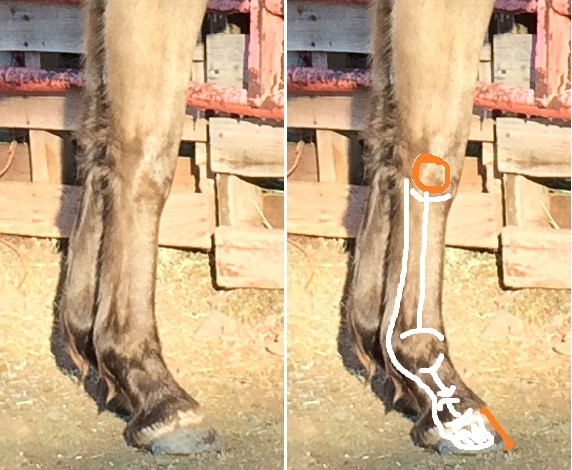Some people look at “wedges” and get a bad taste in their mouth.
“Why?!” What horse would ever need those? They look so alien! How can wedging a hoof “help” the lower limb? What is this madness?!
Let’s take a step back and look at a comparative passion of mine: cars.
Namely, how the suspension works.
I am all about the handling capability of a car. Suspension helps the ride of a car (how comfortable it is to the passengers) and the handling of the car (the ability to brake, corner and accelerate).
I recently had the pleasure of driving in Germany. Oh sweet goodness, I could get used to a life with no speed limits. But I would have to learn German. Der sigh!
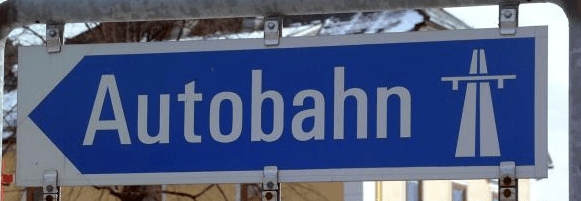
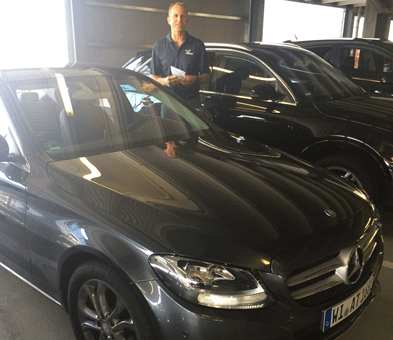
I think we put 2,500km on this little beast on our last tour through Europe.
We think of suspension as the cushion that eats up the road bumps for us, so that we sit smoothly. Some suspension is “firm” which isn’t comfortable at all, but keeps your tires glued to the road.
The average sedan weighs 4,000lbs. With just a driver added, that’s a negligible amount of additional weight, but cram 5 high school football players into a Honda Civic and the question of suspension comes to the forefront. The car needs to be able to competently absorb the upward shock of a road variance against the tire and ALSO compensate for the 1,000+lbs of human passengers, throwing their weight around in the car.

I bet this thing corners wicked good.
If you’ve ridden in really soft suspension, you can hit a bump and ride a “wave” of sloppy suspension for another few minutes. You can corner and feel the whole car sway under the effort. You feel like you are piloting a land yacht that swims all over the place, not a tight sports car that is agile on the road.
If the combined weight of car and human can come close to 5,000lbs, how does the suspension get held in place? Without going over painful detail: it’s springs. They have finite tops and bottoms and are bound into place by metal. Pretty sturdy? Why yes. They can either be long curved pieces of metal (with multiple layers of curved pieces of metal) that can flex on impact. They can be coil-shaped springs that handle shock on each wheel, up and down. But believe me you: they are locked into place at each end of them, no matter which type they are.

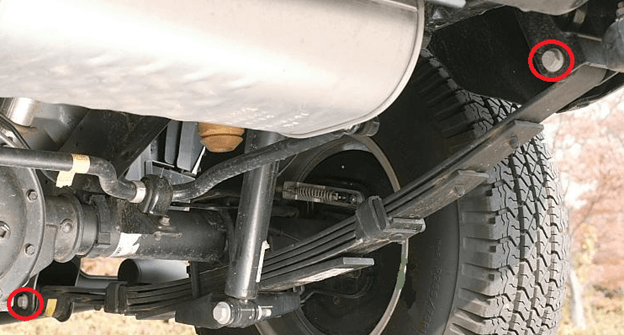
What happens when you lose one of those bolts? Where does that standing tension go? KABOING! That tension is prepared for 700 lbs of resting car (and 3,500lbs of jolting, moving car) to be loaded on that back end. With nothing holding it in position, it’s not supporting anything.
So let’s hop back over to horses. Your Deep Digital Flexor Tendon is attached at a top and a bottom. Your Suspensory Ligament is attached at a top and a bottom. We know what happens when the “leaf spring” fails: we have a tear and a year off.
Here is a kicker: the “bolts” of the horse’s suspension system, should be secured to the mainframe of the horse. What if they aren’t?
If you put a rubber band around two pegs, that are secured to a block of wood, the pressure from the rubber band is met with the pressure of the pegs being fixed in place.
But when you remove the board and the pegs aren’t secured to anything, the rubber band pulls the pegs together and then <PLUNK>, no tension. So your DDFT or your suspensory might not tear (rubber band) but the attachment points, or “bolts” might fail, which is equally as bad a problem: you still have no suspension.
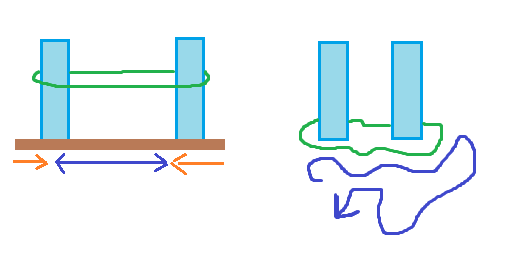
Enter exhibit A: Your horse’s Laminae.
Now, we all know that the Coffin Bone has sensitive laminae sprouting off the front of its wall and that the horn of the hoof has insensitive laminae sprouting from the inside of it’s wall. These two lock together like drawer slides and the hoof stays in one piece.
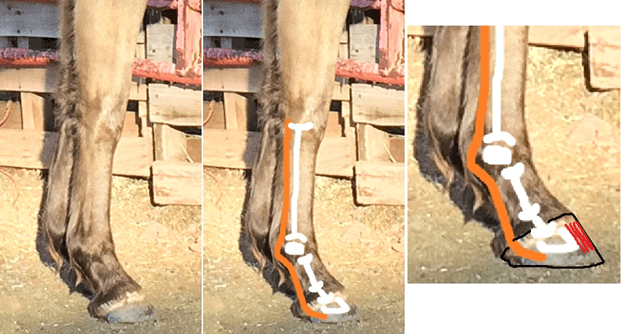
When your laminae is compromised through Laminitis, its grip is not so good. The bad news is, the Deep Digital Flexor tendon is expecting to be bolted in place with enough security to withstand a 1,400 lb horse jumping a 1.2m fence (and the landing: exponentially increases the psi requirement). It won’t tear the tendon, no. Just like your leaf spring won’t break if the bolt comes off. It just falls off.

Same inside your hoof (EEW!) you end up very thoroughly tearing your laminae apart. The coffin bone is like a sweatshirt being tugged by two dogs. The Deep Digital Flexor Tendon carries tension back, which tips it down. The laminae holds it against the stability of the hoof horn, holding it up. If the laminae is weak, it’s like one dog lets go: your coffin bone gets pulled by only one strong side, the DDFT and that sucker will ROTATE.
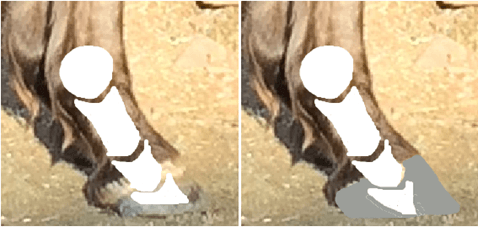
The age old solution has been: put a wedge on it. This tilts the coffin bone down so that the DDFT, which is tied to the bottom of that, can be given more slack.
Sort of like your arm: a line from your shoulder to your wrist has the least amount of tension on it as possible. When you bend your arm, then tension increases around your elbow, where your tissue is “pulled” around that pointy corner and slightly stretched.

The shortest distance between two points is a straight line. If you have a cable that wraps a corner, like a DDFT wraps around a pastern, you have tension. The best way to relieve the tension, is to try and create a straight line, past the pulley you are working with.
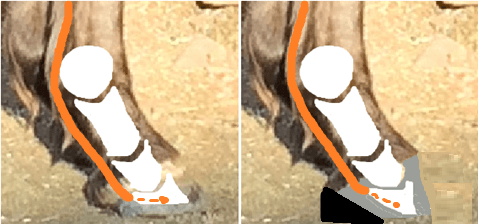
We don’t want that laminae tearing, so the best thing to do is to beat it to the punch and help the WHOLE hoof tilt, so that the coffin bone is supported and the laminae not strained. The DDFT will essentially be moved into as straight a line as possible. This keeps the weak laminae happy and unstrained and keeps the DDFT from having pressure on it, to lessen the pulling. For a horse whose hoof is in so much pain that they have trouble standing, it may look odd to wedge it, as you would think you are furthering an unnatural hoof capsule position and just adding to the madness. Internally, however, you are allowing the DDFT to attain as straight a line as possible = less tension, while keeping the coffin bone as close to the parallel of the dorsal hoof wall, so the laminae isn’t tearing.
And don’t let my fancy Paint sketches fool you: this is the primitive art of a pre-schooler. If you want this done right, a vet will be there doing radiographs and you will have them adjusting your wedge to be the exact angle your horse needs to feel relief. I just wanted to give a simple illustration of when wedges will be useful in a therapy setting, like laminitis.
This is why our newest therapy boot, the Easyboot Cloud, has an accessory for quick wedging.
Holly Jonsson

Director of Sales
Through a lifetime of “horse crazy” and the fortunate experience of riding nearly every shape and size of horse, I got to see a wide array of hoof shapes and sizes. No Hoof, No Horse is very true to me. I want to ensure that horses on every continent have a variety of footwear to pick from, to ensure the best match is found. I want your partner to be happy from the ground up!


